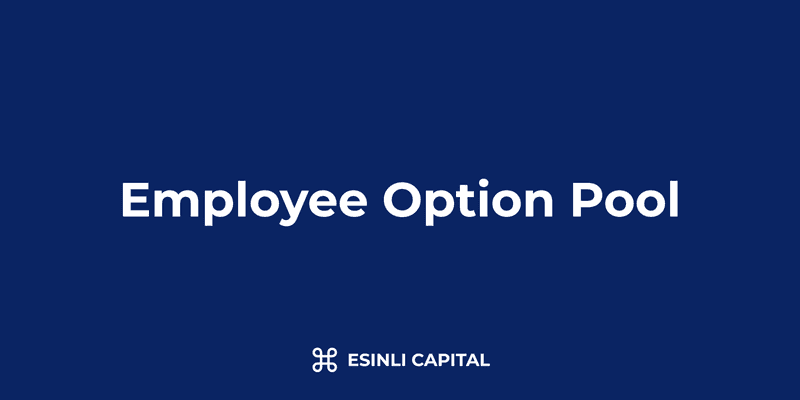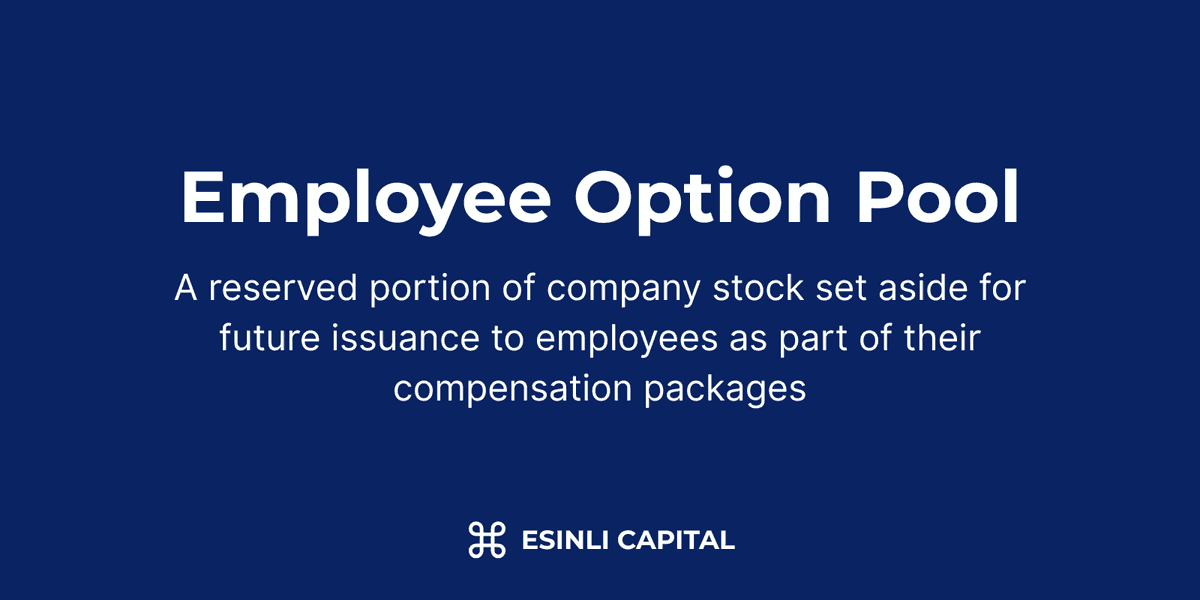In This Article
- What Is an Employee Option Pool?
- Employee Option Pool Size by Company Stage
- Pre-Money vs. Post-Money Option Pools
- Option Pool Refreshes and Expansions
- Strategic Option Pool Planning
- Employee Option Pool and Company Valuation
- Legal and Administrative Considerations
- Employee Option Pool Best Practices
- Option Pool Alternatives and Complements
- The Future of Employee Option Pools
- The Bottom Line
- What Is an Employee Option Pool?
- Employee Option Pool Size by Company Stage
- Pre-Money vs. Post-Money Option Pools
- Option Pool Refreshes and Expansions
- Strategic Option Pool Planning
- Employee Option Pool and Company Valuation
- Legal and Administrative Considerations
- Employee Option Pool Best Practices
- Option Pool Alternatives and Complements
- The Future of Employee Option Pools
- The Bottom Line

Employee Option Pool: Size, Structure & Dilution Impact
KEY TAKEAWAYS
- An employee option pool typically ranges from 10% to 20% of a company's total equity, with early-stage startups often needing larger pools (15-20%) than later-stage companies (5-10%).
- Option pools can be structured as either pre-money or post-money, with pre-money pools causing greater founder dilution as the entire dilution impact falls on existing shareholders.
- Most venture capital term sheets require option pools to be created or expanded before their investment (pre-money), effectively reducing the company's pre-money valuation.
- Strategic option pool planning should align with your 12-18 month hiring roadmap to avoid unnecessary dilution while ensuring sufficient equity for key hires.
- Regular option pool refreshes (typically every 18-24 months) are necessary as companies grow and need additional equity for new hires and retention.
What Is an Employee Option Pool?
An employee option pool is a designated portion of a company's equity reserved for future issuance to employees, advisors, and consultants. This allocation of shares is set aside from the company's authorized shares but not immediately issued, creating a reserve that can be drawn upon as the company makes new hires or provides additional incentives to existing team members.
The option pool serves as a crucial strategic tool for startups, particularly those in the pre-revenue or early growth stages when cash compensation might be limited. By offering equity compensation, companies can attract and retain talented individuals who might otherwise command higher salaries at established organizations. The promise of ownership in a potentially successful venture can be a powerful motivator and alignment mechanism.
Option pools are typically expressed as a percentage of the company's fully diluted capitalization, which includes all outstanding shares plus reserved shares for future issuance. For example, a 15% option pool means that 15% of the company's total equity is set aside for employee options.
How Option Pools Are Created and Structured
Option pools are formally established through board and shareholder approval, often in connection with financing rounds. The creation or expansion of an option pool involves:
- Board approval: The board of directors must approve the allocation of shares to the employee option pool.
- Shareholder approval: Existing shareholders must approve changes to the company's equity structure.
- Option plan documentation: Companies must create or update their equity incentive plan, which governs how options are granted, vested, and exercised.
The timing of when the option pool is created relative to a new investment round has significant implications for dilution, which we'll discuss in detail below.
Employee Option Pool Size by Company Stage
The appropriate size for an option pool varies based on company stage, industry, geographic location, and anticipated hiring needs. Here's a general framework for option pool sizing across different startup stages:
Seed Stage (Pre-Series A)
At the seed stage, companies typically establish larger option pools ranging from 15% to 20% of their fully diluted capitalization. This larger allocation reflects:
- The need to attract founding team members and early employees who take on significant risk
- Limited cash compensation capabilities
- Longer runway required before the next funding event
For example, a seed-stage software company might set aside an 18% option pool to cover its initial technical hires, early sales team, and key operational roles over the next 18-24 months.
Series A and Series B
By Series A, companies typically maintain option pools between 10% and 15%. This moderate reduction reflects:
- Some early positions already filled with equity allocated
- Improved ability to offer competitive cash compensation
- More predictable hiring roadmap
A Series A enterprise SaaS company might maintain a 12% option pool to support its growth in sales, marketing, and product development over the next 12-18 months.
Growth Stage (Series C+)
Later-stage companies generally reduce their option pools to 5-10% of fully diluted shares. This further reduction occurs because:
- The company has more established valuation and lower risk profile
- Cash compensation becomes more competitive and market-rate
- Equity becomes more valuable, requiring smaller grants to attract talent
- Many key positions have already been filled
For instance, a Series C fintech company approaching profitability might maintain just a 7% option pool, primarily focused on strategic executive hires and selective technical roles.
Option Pool Size by Function and Role
Within a company's overall option pool allocation, different roles typically receive varying equity packages based on their strategic importance, market compensation expectations, and replacement difficulty. Here's a typical breakdown:
| Role Level | Early-Stage (% of Pool) | Growth-Stage (% of Pool) | Notes |
|---|---|---|---|
| C-Level Executives | 1-3% each | 0.5-1.5% each | COO, CTO, and CFO typically command the largest allocations |
| VP-Level | 0.5-1.5% each | 0.2-0.75% each | Engineering and product VPs often receive higher allocations |
| Director-Level | 0.3-0.75% each | 0.1-0.3% each | Technical directors generally receive more than operational roles |
| Senior Individual Contributors | 0.1-0.5% each | 0.05-0.2% each | Senior engineers and key sales roles receive premium allocations |
| Mid-level Employees | 0.05-0.2% each | 0.02-0.1% each | Varies widely based on experience and company stage |
| Junior Employees | 0.01-0.1% each | 0.01-0.05% each | Typically standardized within bands at later stages |
It's important to note that these percentages represent fully diluted ownership, and actual option grants would be calculated based on the company's current share count and option pool size.
Pre-Money vs. Post-Money Option Pools
One of the most consequential aspects of option pool planning involves when the pool is created or expanded relative to a new financing round. This timing question creates a critical distinction between pre-money and post-money option pools, with significant implications for founder and existing shareholder dilution.
Pre-Money Option Pools
A pre-money option pool is created or expanded before a new investment is made, effectively reducing the company's pre-money valuation. Since the option pool is considered part of the company's existing equity structure when the new investment is made, the dilution impact falls entirely on existing shareholders, not on the new investors.
Example of Pre-Money Option Pool Dilution:
Assume a startup with the following cap table before a Series A round:
- Founders: 7,000,000 shares (70%)
- Seed Investors: 3,000,000 shares (30%)
- Total: 10,000,000 shares (100%)
The company is raising a $5 million Series A at a $15 million pre-money valuation. The term sheet requires a 15% post-money option pool. Here's what happens:
- Pre-money valuation: $15 million
- New option pool needed: 15% post-financing = 15% of $20 million company
- Share price for financing: $15 million ÷ 10,000,000 = $1.50 per share
- New investor shares: $5 million ÷ $1.50 = 3,333,333 shares (20% post-financing)
- Option pool shares needed: 15% of post-financing = 15% × (10,000,000 + 3,333,333) ÷ 85% = 2,352,941 shares
Post-Financing Cap Table:
- Founders: 7,000,000 shares (now 47.1%)
- Seed Investors: 3,000,000 shares (now 20.2%)
- Series A Investors: 3,333,333 shares (22.4%)
- Option Pool: 2,352,941 shares (15.8%)
- Total: 14,686,274 shares (100%)
The founders' ownership decreased from 70% to 47.1%, with dilution coming from both the new investment (20%) and the option pool (15%). This represents significant dilution beyond just the investment itself.
Post-Money Option Pools
A post-money option pool is created or expanded after a new investment, with the dilution impact shared proportionally among all shareholders, including the new investors. This structure is generally more founder-friendly but less common in venture financings.
Example of Post-Money Option Pool Dilution:
Using the same starting point as above:
- Founders: 7,000,000 shares (70%)
- Seed Investors: 3,000,000 shares (30%)
- Total: 10,000,000 shares (100%)
With a $5 million Series A at a $15 million pre-money valuation, but with the option pool created post-investment:
- Pre-money valuation: $15 million
- Share price for financing: $15 million ÷ 10,000,000 = $1.50 per share
- New investor shares: $5 million ÷ $1.50 = 3,333,333 shares
- Post-financing cap table (before option pool):
- Founders: 7,000,000 shares (52.5%)
- Seed Investors: 3,000,000 shares (22.5%)
- Series A Investors: 3,333,333 shares (25%)
- Total: 13,333,333 shares (100%)
- Option pool creation (15% post-creation): 15% × 13,333,333 ÷ 85% = 2,352,941 shares
Final Cap Table:
- Founders: 7,000,000 shares (44.6%)
- Seed Investors: 3,000,000 shares (19.1%)
- Series A Investors: 3,333,333 shares (21.3%)
- Option Pool: 2,352,941 shares (15%)
- Total: 15,686,274 shares (100%)
In this scenario, the founders retain 44.6% ownership versus 47.1% in the pre-money option pool scenario—a significant difference of 2.5% more ownership.
Negotiating Option Pool Structure
While pre-money option pools are standard in venture financing, founders can negotiate several aspects:
- Pool size: Back your proposed pool size with a detailed hiring plan to justify only what you truly need
- Partial post-money structure: Negotiate for a portion of the pool to be created post-investment
- Two-stage pool creation: Establish a smaller immediate pool with provisions for expansion at specific milestones
- Existing pool consideration: Ensure unused portions of existing pools are credited against new requirements
Option Pool Refreshes and Expansions
As startups grow and evolve, they frequently need to replenish or expand their option pools through what's known as an "option pool refresh." These refreshes typically happen every 18-24 months, often coinciding with new financing rounds.
When to Consider an Option Pool Refresh
Several indicators suggest it's time to refresh your option pool:
- Low remaining allocation: When your unallocated pool drops below 3-5% of your fully diluted shares
- Upcoming key hires: When you anticipate executive or strategic hires requiring significant equity
- New funding round: When negotiating a new financing that will dilute existing equity
- Retention concerns: When you need additional equity for refresher grants to retain key talent
- Changing market conditions: When the competitive landscape for talent shifts, requiring more generous equity packages
How to Structure an Option Pool Refresh
Option pool refreshes can be structured in various ways:
- Standard expansion: Increase the pool by a fixed percentage of fully diluted shares
- Top-up mechanism: Expand the pool only to a predetermined target percentage
- Milestone-based expansion: Create a framework for incremental pool increases tied to company performance
- Rolling refresh: Establish a schedule for regular, smaller pool expansions to minimize single-point dilution events
Option Pool Refresh Example
Consider a Series B company with the following cap table:
- Founders: 35%
- Investors: 50%
- Existing option pool: 15% (with only 2% remaining unallocated)
The company is planning its Series C round and needs to expand its option pool. Here's a potential approach:
- Analyze hiring needs: Determine that 8% additional equity is needed for the next 18-24 months
- Negotiate with investors: Agree on a 10% post-money option pool (recognizing the 2% already unallocated)
- Structure the refresh: Implement a pre-money expansion of 8% before the Series C investment
- Resulting ownership: After the Series C investment and option pool refresh, founders might own 28%, existing investors 40%, new investors 22%, and the option pool 10%
Strategic Option Pool Planning
Effective option pool management requires strategic planning beyond just sizing considerations. Here are key strategic elements to incorporate:
Aligning with Your Hiring Roadmap
Your option pool size should directly correspond to your anticipated hiring needs over the next 12-18 months. To determine these needs:
- Create a detailed hiring plan: Identify all roles you expect to fill, when you'll fill them, and their strategic importance
- Assign equity bands: Establish equity ranges for each position based on market data and company stage
- Calculate total equity needs: Sum the maximum equity you might need across all planned positions
- Add a buffer: Include a 15-25% cushion for unexpected hires or competitive situations
- Compare to benchmarks: Verify your calculated needs against industry standards for your stage
Managing Option Pool Dilution
To minimize unnecessary dilution while ensuring sufficient equity for talent acquisition:
- Use equity guidelines: Develop standardized equity bands by role and level to ensure consistency
- Implement vesting cliffs: Standard 4-year vesting with a 1-year cliff ensures equity is earned over time
- Recover unvested equity: Establish clear procedures for returning unvested shares to the pool when employees depart
- Consider accelerated vesting sparingly: Reserve accelerated vesting provisions for select executive roles
- Track pool utilization: Regularly monitor pool usage against projections to identify trends
Communicating Option Pool Strategy to Stakeholders
Different stakeholders have different perspectives on option pools:
For Investors:
- Focus on the strategic hiring plan supporting your proposed pool size
- Demonstrate thoughtful equity guidelines that balance competitiveness with capital efficiency
- Provide data on comparable companies' option pool sizes and structures
For Employees:
- Explain how equity grants relate to company valuation and potential outcomes
- Provide education on vesting schedules, exercise mechanisms, and tax implications
- Offer transparency on the company's financing history and capitalization structure
For Board Members:
- Present regular updates on pool utilization and allocation
- Provide competitive analysis of equity compensation trends in your industry
- Connect option pool strategy to broader talent acquisition and retention goals
Employee Option Pool and Company Valuation
Option pools have complex relationships with company valuation that founders should understand:
Impact on Pre-Money Valuation
A pre-money option pool effectively reduces a company's pre-money valuation from the founders' perspective. Consider this example:
- Headline valuation: $20 million pre-money
- Required option pool expansion: 15% (post-money)
- Effective pre-money valuation after option pool creation: $17 million
This $3 million difference represents equity value transferred from existing shareholders to future employees rather than to new investors, but it still constitutes dilution.
Option Pool Accounting in Valuation Calculations
When comparing deal terms across investment opportunities, investors and founders should standardize option pool assumptions:
- Fully diluted capitalization: Always consider option pools in fully diluted share calculations
- Pre-money valuations: Specify whether valuations are quoted before or after option pool expansions
- Post-money calculations: Clarify whether post-money valuations include newly created or expanded option pools
Investor Expectations by Region and Stage
Venture capital expectations for option pool size vary by region and company stage:
Silicon Valley/US:
- Seed: 15-20%
- Series A: 12-15%
- Series B: 10-12%
- Series C+: 5-10%
Europe:
- Seed: 10-15%
- Series A: 10-12%
- Series B: 8-10%
- Series C+: 5-8%
Asia:
- Seed: 10-15%
- Series A: 8-12%
- Series B: 7-10%
- Series C+: 5-7%
Legal and Administrative Considerations
Proper management of option pools requires attention to legal and administrative details:
Option Plan Documents
The core legal documents governing your option pool include:
- Equity Incentive Plan: The formal plan document approved by the board and shareholders
- Option Agreement: The contract between the company and individual option recipients
- Exercise Agreement: The document executed when options are converted to shares
- Board Approvals: Minutes documenting option grants and pool expansions
- 409A Valuation: Independent assessment establishing the fair market value for option strike prices
Tax Implications of Different Option Types
Option pools typically contain different types of equity instruments with varying tax treatments:
Incentive Stock Options (ISOs):
- Available only to employees
- Potentially favorable tax treatment with no tax at grant or exercise (though AMT may apply)
- Capital gains treatment possible if holding periods met
Non-Qualified Stock Options (NSOs):
- Available to employees, consultants, advisors, and directors
- Taxed as ordinary income on the spread between strike price and fair market value at exercise
- Company receives tax deduction for the amount of ordinary income recognized
Restricted Stock Units (RSUs):
- Taxed as ordinary income when shares vest
- No upfront purchase required by employees
- More common at later-stage companies
Common Administrative Challenges
Option pool management comes with several administrative challenges:
- 409A compliance: Ensuring option strike prices meet fair market value requirements
- Grant documentation: Maintaining proper records of all equity grants and board approvals
- Vesting tracking: Monitoring vesting schedules across all option recipients
- Termination processing: Handling option treatment when employees depart
- Exercise window management: Administering exercise deadlines for departed employees
Employee Option Pool Best Practices
To optimize your option pool strategy:
Benchmarking and Market Data
Use reliable data sources to inform your equity strategy:
- Compensation surveys: J.Thelander, Radford, and OptionImpact provide detailed equity data
- Investor reports: Many VC firms publish annual compensation studies with equity benchmarks
- Peer company exchanges: Informal CEO networks often share anonymized compensation data
- Hiring feedback: Gather information on competitive offers from candidates in your hiring process
Equity Allocation Frameworks
Develop frameworks to guide equity decisions:
- Level-based bands: Create equity ranges for each organizational level
- Impact-adjusted allocation: Modify standard allocations based on role criticality and impact
- Geographically-adjusted guidelines: Adjust equity based on location and local market expectations
- Experience multipliers: Apply multipliers for exceptional experience or expertise
Employee Communication and Education
Help employees understand and value their equity:
- Equity education sessions: Conduct regular workshops on equity fundamentals
- Grant documentation: Provide clear summaries of vesting terms and potential outcomes
- Value illustrations: Show potential equity values under different exit scenarios
- Tax guidance resources: Offer information about tax implications and planning opportunities
- Regular updates: Share company progress and how it relates to equity value
Option Pool Alternatives and Complements
While traditional option pools remain standard, companies can consider alternatives:
RSU Programs
Restricted Stock Units (RSUs) offer several advantages:
- No exercise required: Employees receive shares automatically upon vesting
- Reduced downside risk: Value exists even if share price doesn't increase dramatically
- Simpler tax treatment: Taxed as ordinary income at vesting, no AMT complications
RSUs become increasingly common as companies grow, with many switching from options to RSUs around Series C or D stages.
Profit-Sharing Arrangements
Some companies complement equity with profit-sharing:
- Cash bonuses: Tied to company profitability or revenue targets
- Phantom equity: Synthetic equity that pays out based on value creation without actual shareholding
- Performance units: Cash-settled instruments tied to specific business metrics
Long-Term Incentive Plans (LTIPs)
More mature companies often develop comprehensive LTIPs:
- Multi-year performance cycles: Typically 3-5 year measurement periods
- Blended metrics: Combining financial and operational targets
- Tiered rewards: Different payout levels based on achievement thresholds
The Future of Employee Option Pools
The equity compensation landscape continues to evolve:
Emerging Trends
Notable trends shaping option pool strategies include:
- Extended exercise windows: Many companies now offer 5-10 year post-termination exercise periods versus the traditional 90 days
- Early exercise provisions: Allowing option holders to exercise unvested options for better tax treatment
- Secondary transactions: Facilitated opportunities for employees to sell portions of vested equity before exits
- Hybrid equity models: Combining traditional options with performance-based equity or cash incentives
- Crypto token models: Blockchain startups exploring token-based incentive structures alongside traditional equity
Regulatory Developments
Stay informed about evolving regulations affecting option pools:
- Tax law changes: Potential modifications to capital gains rates or qualified small business stock exemptions
- SEC rule updates: Evolving requirements for equity compensation disclosures and shareholder approvals
- International considerations: Varying treatment of equity compensation across different jurisdictions as companies expand globally
The Bottom Line
An employee option pool represents one of the most strategic tools in a startup's arsenal for attracting, retaining, and motivating top talent. When structured thoughtfully, it aligns employee incentives with company success while managing dilution for founders and investors.
The key to option pool success lies in balancing competing priorities: providing competitive equity packages while minimizing unnecessary dilution, creating sufficient reserves without overallocating, and satisfying investor expectations while protecting founder ownership.
By understanding the nuances of option pool creation, structure, and management outlined in this guide, founders and executives can make informed decisions that optimize their equity strategy across their company's entire growth journey.
Whether you're establishing your first option pool or planning your third expansion, remember that equity is more than just a compensation tool—it's a powerful mechanism for building a culture of ownership and shared destiny that drives startup success.



